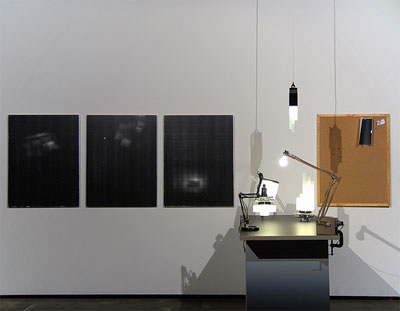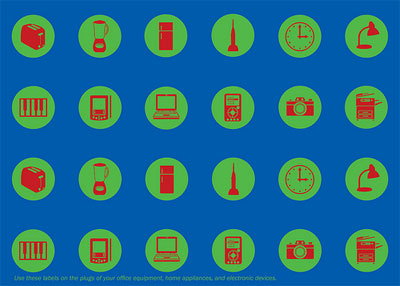
Sarah Cook kindly took a moment to speak to me this week about the exhibition she curated, "Untethered", which opens tonight at Eyebeam in New York. The group exhibition, which takes the form of a sculpture garden and explores "everyday objects deprogrammed of their original function, embedded with new intelligence, and transformed into surrealist and surprising readymades", includes 15 artists, many of whom are current or former Eyebeam fellows or residents. "Untethered" will remain up through October 25th. - Ceci Moss
Ceci Moss: How did you first begin working on "Untethered"?
Sarah Cook: Preamble: I am an inaugural curatorial fellow at Eyebeam through my work with CRUMB (Curatorial Resource for Upstart Media Bliss). My position was enabled by a three-year grant received by CRUMB, which allows me to use Eyebeam as a site for research into curating new media art, the question of how collaboration works through international networks, and how curators can work in lab environments. I arrived in New York in April; before that Amanda McDonald Crowley and I had been discussing whether I should take advantage of an opportunity to curate an exhibition as part of the Fall program as one way to put my research into practice, given that exhibition practice is my strength. Eyebeam was interested in challenging that and allowing me, through my fellowship, to think about curating in a different way.
Together with Liz Slagus, Director of Education and Public Programs at Eyebeam, I visited with all of Eyebeam's resident artists and fellows (I had participated in the juries which had selected them) and got to know what they were working on in the labs. At the same time, I tried to learn about Eyebeam's exhibition history, its use of its spaces, how it communicates with the outside world - the art and the technology communities - its research interests and its future. Two things happened: the first was that I was pleased to discover work-in-progress that I loved because it seemed otherworldly, or magical in the way it made reference to the real world, to technology, to art, and to space, in particular projects by Eyebeam residents Joe Winter and JooYoun Paek, and Eyebeam fellows Addie Wagenknecht, Jessica Banks and Ayah Bdeir. The tangibility of the labs and the physicality of what people at Eyebeam were making really interested me. The second was that through discussions with Liz and others I realized there was a need to begin and sustain discussions at Eyebeam around open-source and re-use, and not just software but hardware -- all towards opening up the process of making. Beyond Eyebeam, I also felt that I was tiring of new media exhibitions that rely on video documentation, screens, text, and proof-of-concept, and I wanted to question one of the assumptions that the art world has about new media, namely that it isn't an object. As JooYoun Paek noted, in New York you are aware of all the stuff surrounding you, the things on the street, and so I guess I felt challenged by Eyebeam, by the artists, and by West 21st Street, so I began to think about what kind of object-based show could be specific to this site. Sorry, that was a bit convoluted, but Eyebeam is a place where there are always a hundred things going on and it was a challenge to begin with -- getting to that point where I could chose from all the different things that interested me and then follow that path.
It helped that last spring I also read an interesting interview with Jonathan Zittrain about his book The Future of the Internet. He came up with the right word to describe a practice many artists I know have been familiar with for a long time -- untethering or unlocking devices from their normal or proprietary use, for both political and aesthetic reasons. This felt timely, and felt like it was about more than just hacking because you could. I presented my nascent ideas, and a range of visual art projects I knew of which seemed to relate to what I saw happening within Eyebeam at a StopWork gathering (which we have once every few months) and people seemed excited by the works I was interested in. We decided I should go ahead and curate this exhibition, by continuing to have discussions with the artists in-house and inviting others from outside.
Not to make the story any longer, but I then finally found time to read Sherry Turkle's edited collection of essays on "Evocative Objects" and, so, have since enjoyed delving into this area -- where artists use technology to change the 'things we think with'. I am now sitting somewhere between Chris Csikszentmihalyi's thinking on Edgy Products and all the art world jargon about object-oriented relational aesthetics...but that's a longer discussion for another time.
How would you define an "untethered" readymade? What is its connection to use, value, and commodity, given the open model presented by "generative" practices?
'Use', 'value' and 'commodity' have always been slightly loaded terms when it comes to New Media Art, perhaps more than with other traditional forms of art. No doubt these are contentious terms in the labs at Eyebeam, where you have, on one hand, artists releasing their projects with instructions into the public domain and not interested in art which isn't both free and useful in a life-changing way, and, on the other hand, artists designing new products and (potentially commodifiable) aesthetic event experiences (I'm generalizing slightly of course). [Sidenote: the other exhibition on view at Eyebeam right now is the Incubate-curated show "Other Options", which addresses directly the question of art economies.] I could regress to my philosophy-studying days and talk about Kant's notion of art as something which invites you to make a pure reasoned judgment beyond any ideas of utility, and Heidegger's definitions of technology as objects either ready to hand (very tangibly useful) or present at hand (potentially valuable for how you might use them). Instead, if I try to stick within an art historical discourse and keeping the works in "Untethered" in mind, then I suppose I like the idea of the readymade because, as Margit Rowell has written, it is a thing that is not just displaced (bottle rack turned upside down or urinal unplumbed) but also deprogrammed (bicycle wheel on a stool; these are the Duchampian examples she cites). Readymades are things not just made useless but given another use, as art. So what does that mean when both the original thing and the art are technological (supposedly inherently useful), and you are invited to participate in the re-use?
Justin Downs, who has been working on the exhibition design with me, and I have tried to classify or group the objects in the exhibition into categories suggestive of their evolution from thing to object, hardware to art, through these changes in use. These groupings deal with philosophical and abstract ideas about technology as tool with the potential to be both displaced from you and deprogrammed by you (or something in between). These include: those works where the function has changed and been made generative or open to change by you (the garbage bags in the Not Bicycle Cover or the Hans Christoph Steiner's PDAs which are now music-making machines); those works where the nature or behavior of the object, but not its function, has changed (Thomson and Craighead's Unprepared Piano still plays, but now plays random parts of scores from internet MIDI files; Jessica Banks and Ayah Bdeir's chandelier still casts light but continually redraws itself Paul DeMarinis' metronome still keeps time, but now hypnotises as well) - they're all tethered to new intelligences independent of you; and lastly those works which are most surrealistically or surprisingly 'readymade' in the traditional sense, or otherworldly creations outside you, as in Michel de Broin's asteroid of nearly depleted batteries or Joe Winter's Xerox copier which now acts as an astronomical observation device.

It seems an exhibition of this nature would encourage interaction with visitors. How is the "sculpture garden" installed? Does it open itself up to this sort of exchange?
The invitation card is a kind of exchange object - it is made of stickers which you can use to label the wires for your appliances and devices (those wires which are all tethered and tangled under your desk). Within the exhibition, related to those groupings mentioned above, the object labels also indicate whether the works invite your interaction or not (some are sculptures, others perform for you without your interaction, others, like Kelly Dobson's blender, or Sascha Pohflepp's camera, require your participation), and the categories suggest different 'paths' around the space. In some ways the sculpture garden aesthetic just comes from opening up the skylights, not building any additional walls, keeping the space wide open, and putting the works on pedestals. It's about the feel of wandering between objects in a space and deciding what your own relationships to them could be.

However, the entire program accompanying the exhibition "Untethered," and Eyebeam ethos, is about exchange - so, for instance, on October 14 Hans-Christoph Steiner is hosting a workshop on untethering or jail-breaking iPods and PDAs based around the devices he has in the show. It is also hoped that Eyebeam's newly launched Open Culture Research group will take advantage of the exhibition to host meetings with artists about questions of open-sourcing hardware, patents and the like.
Lastly, will there be documentation of these projects online for those unable to visit the exhibit?
Some of the projects, because they are prototypes, are well documented on the artists' own websites, or on the Eyebeam development wiki. Related to the sculpture garden aesthetic we have produced an audio-guide for the exhibition, with a track for each work, in which the artist describes the piece and how it relates to their practice. You'll be able to download this from the Eyebeam website and listen to it as you walk around the show, or use it to experience the show at a distance. We'll be uploading photos to Eyebeam's flickr page.
Thank you, Sarah!

